Gathering and defining software requirements is difficult.
One Agile technique to help address this challenge is writing user stories, which are short descriptions of functions that an end-user would want.
While user stories help convert concepts into functions, writing good user stories is easier said than done.
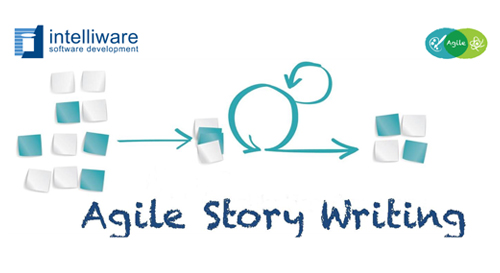
What you’ll learn in this presentation:
- The basics of user stories.
- How user stories fit into the overall Agile planning process.
- How to write a user story.
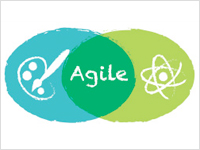
Why is it so Difficult to Determine Software Requirements?
Requirements gathering is when informal ideas become formal concepts:
- Converting a concept into something concrete is almost always more difficult than it is initially believed to be.
- The concept of what the concrete version needs to look like changes frequently.

Why are Requirements So Important?
According to Fred Brooks (the author of The
Mythical Man Month):
- “The hardest single part of building a software
system is deciding precisely what to build. No
other part is as difficult…No other part of the work
so cripples the resulting system if done wrong.”1 - According to Barry Boehm (Software Engineering
Economics) and other software engineering
experts, around 75-80% of all errors found in
software projects can be traced back to the design
and requirements phases
1Brooks, Frederick P., 1987. “No Silver Bullet: Essence and Accidents of Software Engineering”, Computer, Volume 20, No. 4.
2Boehm, W .Barry. “Software Engineering Economics”. Prentice Hall; 1 edition (Oct. 22 1981).
The Challenges with Written Requirements
According to Mike Cohn, author of User Stories Applied:
-
-
- “Writing things down is no guarantee that customers will
get what they want; at best they’ll get what they wrote
down.”3
- “Writing things down is no guarantee that customers will
-
From Lean Software Development by Mary & Tom
Poppendieck, the Seven Wastes of Software
Development:4
- Partially Done Work
- Extra Processes (paperwork)
- Extra Features
- Task Switching
- Waiting
- Motion
- Defects
3 Cohn, Michael W., 2004. “User Stories Applied for Agile Software Development”, (Addison-Wesley Professional Series, Boston, MA).4 Poppendieck, Mary and Poppendieck, Tom, 2003. “Lean Software Development: An Agile Toolkit”, (Addison-Wesley Professional Series, Boston, MA).
What is a User Story
There are numerous definitions for stories.
A common definition:
A short description of a function that an end-user would want.
- From Kent Beck: “One thing the customer wants the system
to do…(it) should be testable.”5 - From Ron Jeffries: “Stories are promises for…the series of conversations that will take place between the customer and the programmers.”6
5 Beck, Kent, 2000. “Extreme Programming: Embrace Change”, (Addison-Wesley, Boston, MA)6Jeffries, Ron, Anderson, Ann and Hendrickson, Chet, 2001. “Extreme Programming Installed”, (Addison-Wesley, Boston, MA)
3 Cohn, Michael W., 2004. “User Stories Applied for Agile Software Development”, (Addison-Wesley Professional Series, Boston, MA).4 Poppendieck, Mary and Poppendieck, Tom, 2003. “Lean Software Development: An Agile Toolkit”, (Addison-Wesley Professional Series, Boston, MA).
Why User Stories?
Stories have many advantages.
- Easy to understand – Written in non-technical language that customers / product owners can relate to.
- Work at the right level – Not too detailed, are easy to manipulate and move around, like a deck of cards.
- Relatively easy to create – Writing stories takes some skill, but experts can define entire systems for planning purposes in a matter of hours.
3 Cohn, Michael W., 2004. “User Stories Applied for Agile Software Development”, (Addison-Wesley Professional Series, Boston, MA).4 Poppendieck, Mary and Poppendieck, Tom, 2003. “Lean Software Development: An Agile Toolkit”, (Addison-Wesley Professional Series, Boston, MA).
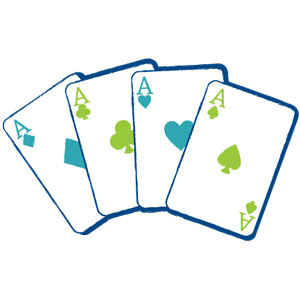
Story Types
 Epic
Epic
-
-
- Represents multiple features or many stories.
- Can take months to build and works at the release level.
- What the end users tend to focus on.
-
 Feature
Feature
-
-
- Smaller than epics, but bigger than stories.
- Can take weeks, possibly one or more Iterations to build.
- What customers / product owners tend to focus on
-
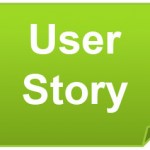 User Story
User Story
-
-
- Are the smallest increment of value.
- Take days, perhaps a week or two at most to build.
- What development teams tend to focus on.
-
Key Players: Customers & Developers
Customers / product owners
- The people who know how to do what the system is going to be doing.
- They either are the end user or they are representative of the eventual user of the system.
Programmers
- The people who will be building, testing, deploying, documenting & training those who will use the system.
Stories are key to fulfilling the requirements in the Customer and Programmers Bills of Rights.
3 Cohn, Michael W., 2004. “User Stories Applied for Agile Software Development”, (Addison-Wesley Professional Series, Boston, MA).4 Poppendieck, Mary and Poppendieck, Tom, 2003. “Lean Software Development: An Agile Toolkit”, (Addison-Wesley Professional Series, Boston, MA).
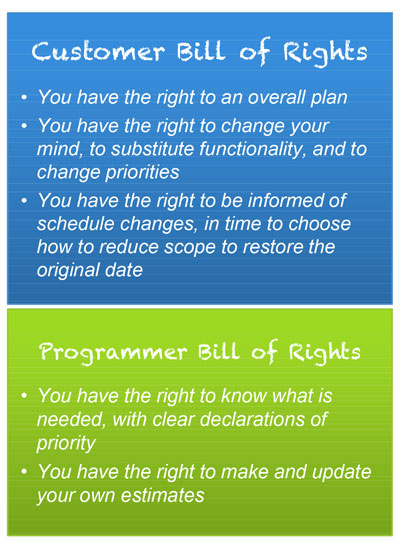
User Story Components
At minimum, a user story has:
-
-
- A card to write the story on.
- A name that the customers and developers understand.
- A description (should be limited to one or two sentences).
- Acceptance criteria to define when the story will be considered completed.
- A size estimate for time management.
-
3 Cohn, Michael W., 2004. “User Stories Applied for Agile Software Development”, (Addison-Wesley Professional Series, Boston, MA).4 Poppendieck, Mary and Poppendieck, Tom, 2003. “Lean Software Development: An Agile Toolkit”, (Addison-Wesley Professional Series, Boston, MA).
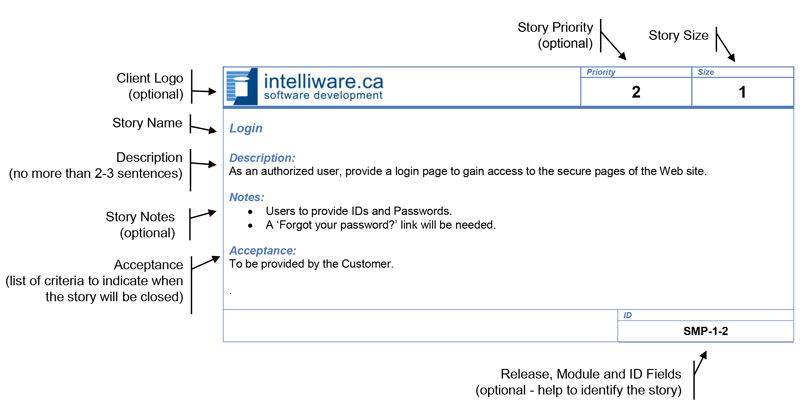
Story Actions
At minimum, a user story has:
-
-
- A card to write the story on.
- A name that the customers and developers understand.
- A description (should be limited to one or two sentences).
- Acceptance criteria to define when the story will be considered completed.
- A size estimate for time management.
-
Stories can be:
Split
- A large story can be split into two or more smaller ones of different sizes; useful for breaking up epics.
Combined
- Two or more small stories can be combined into one.
Added
- New stories can be added to an existing backlog.
Deleted
- Existing stories can be deleted from a backlog.
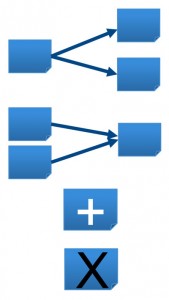
The 3 Cs of Stories
- A token to represent some customer functionality.
- Stories represent customer requirements rather than document them.
- Using a card keeps the story short.
Conversation
- Customers and developers discuss the details of the story at the
time it is to be developed, not before then.
Confirmation
- The customer should provide acceptance tests for the story, and
then see them run to confirm that the story has been completed.
Stories can be:
Split
-
- A large story can be split into two or more smaller ones of different sizes; useful for breaking up epics.
Combined
-
- Two or more small stories can be combined into one.
Added
-
- New stories can be added to an existing backlog.
Deleted
-
- Existing stories can be deleted from a backlog.
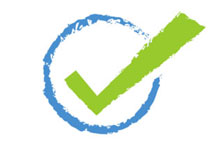

User Roles and Description Formats
- Identifying user roles helps with writing stories.
- Standard story description template:
- As a [role], provide [function] so that [business value].
- Some simple examples:
- As a customer, provide a button that I can use so that I can connect directly with the call centre when my order gets stuck.
- As a call centre rep., review orders in progress online so that I can help customers complete their orders.
- As a manager, access stats on incomplete online orders so that I can make decisions on how to improve the ordering process.
Stories can be:
Split
-
- A large story can be split into two or more smaller ones of different sizes; useful for breaking up epics.
Combined
-
- Two or more small stories can be combined into one.
Added
-
- New stories can be added to an existing backlog.
Deleted
-
- Existing stories can be deleted from a backlog.
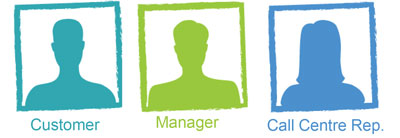
Writing Stories – The INVEST Framework7
- Independent – Dependencies between stories should be avoided.
- Negotiable – Stories should be written so that the details can be negotiated in a conversation between the customer and the development team.
- Valuable – The feature should have business value to the customer.
- Estimatable – Stories should be understood well enough by customers and should be small enough to be “estimatable”.
- Small – Stories that are too big are not useful in planning.
- Testable – It must be possible for the development team to write tests for the story.
7Wake,Bill. “INVEST in Good Stories, and SMART Tasks”. Posted August 17, 2003 on XP123.
Stories can be:
Split
-
- A large story can be split into two or more smaller ones of different sizes; useful for breaking up epics.
Combined
-
- Two or more small stories can be combined into one.
Added
-
- New stories can be added to an existing backlog.
Deleted
-
- Existing stories can be deleted from a backlog.
User Story vs. Use Cases
A story can be considered similar to a lightweight use case.
A story can represent a small piece of a use case.
Use cases cut across many functions and may touch on many stories.
Stories can be:
Split
-
- A large story can be split into two or more smaller ones of different sizes; useful for breaking up epics.
Combined
-
- Two or more small stories can be combined into one.
Added
-
- New stories can be added to an existing backlog.
Deleted
-
- Existing stories can be deleted from a backlog.
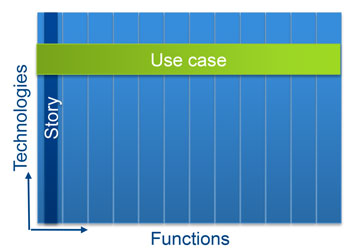
Examples of Common Story Mistakes
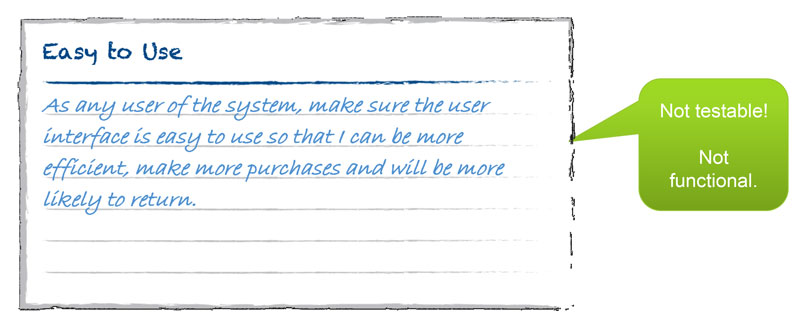
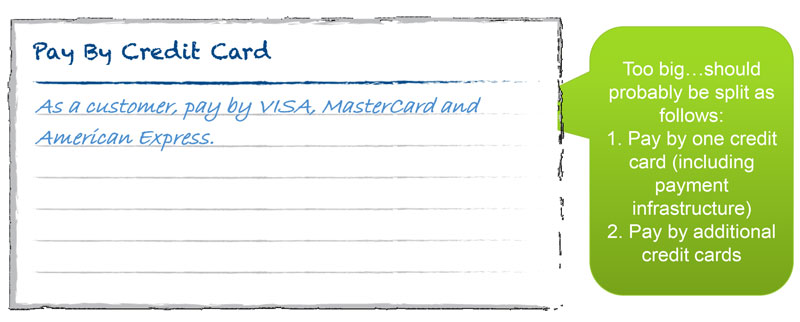
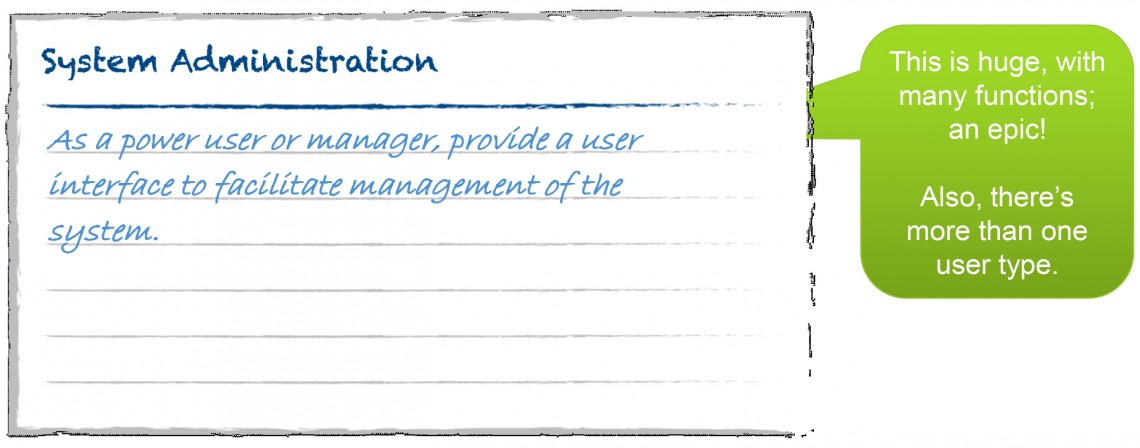
More Information
Mike Cohn’s site contains a good section on user stories:
http://www.mountaingoatsoftware.com/agile/user-stories
The Agile Alliance site is also a good resource:
http://guide.agilealliance.org/guide/user-stories.html
Intelliware’s Knowledge Centre contains several resources on the basics of Agile:
http://www.www.intelliware.com/knowledge-centre